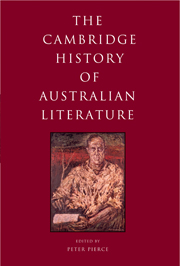Book contents
- Frontmatter
- Introduction
- FROM EUROPEAN IMAGININGS OF AUSTRALIA TO THE END OF THE COLONIAL PERIOD
- FROM THE LATE NINETEENTH CENTURY TO 1950
- TRAVERSES
- 13 Australian children’s literature
- 14 Representations of Asia
- 15 Autobiography
- 16 Riding on the ‘uncurl’d clouds’: The intersections of history and fiction
- FROM 1950 TO NEARLY NOW
- Select bibliography
- Index
- References
13 - Australian children’s literature
from TRAVERSES
Published online by Cambridge University Press: 28 May 2011
- Frontmatter
- Introduction
- FROM EUROPEAN IMAGININGS OF AUSTRALIA TO THE END OF THE COLONIAL PERIOD
- FROM THE LATE NINETEENTH CENTURY TO 1950
- TRAVERSES
- 13 Australian children’s literature
- 14 Representations of Asia
- 15 Autobiography
- 16 Riding on the ‘uncurl’d clouds’: The intersections of history and fiction
- FROM 1950 TO NEARLY NOW
- Select bibliography
- Index
- References
Summary
I frame this account of the history of Australian children’s literature between two texts: the first Australian-published book for children, A Mother’s Offering to Her Children (1841), and Shaun Tan’s The Arrival (2006). A Mother’s Offering was directed to British-born and first-generation children of British settlers, introducing them to the dangers and wonders of Australia; The Arrival follows the journey of a migrant, who leaves his wife and daughter in their impoverished town to seek a better life for his family. It would be an oversimplification to say that A Mother’s Offering is didactic while The Arrival is not, since writing for children is always informed by socialising agendas, overt and covert. Although the texts differ sharply in their mode of address and the subject positions they offer readers, they are alike in their preoccupation with how newcomers to a strange land make sense of the multiple forms of strangeness they encounter. A Mother’s Offering interprets Australia to child readers, offering explanations for its geographical and botanical features and the lives and culture of Aboriginal people, or ‘natives’. The Arrival works as a meditation on diasporic and refugee experience, and the processes whereby a stranger becomes a citizen. For my purposes, the two texts function as bookends, drawing attention to the vast shifts of sentiment and representation which characterise Australian children’s literature between 1841 and 2006.
- Type
- Chapter
- Information
- The Cambridge History of Australian Literature , pp. 282 - 302Publisher: Cambridge University PressPrint publication year: 2009
References
- 2
- Cited by

